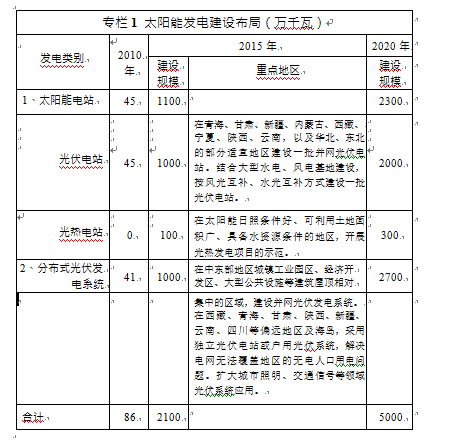前 言
太阳能资源丰富,分布广泛,开发利用前景广阔。太阳能发 电作为太阳能利用的重要方式,已经得到世界各国的普遍关注。 近几年,太阳能发电技术进步很快,产业规模持续扩大,发电成 本不断下降,在全球已实现较大规模应用。在国际市场的带动下, 我国太阳能光伏产业快速发展,光伏技术和成本上均已形成一定 的国际竞争力。从发展趋势看,太阳能发电即将成为技术可行、 经济合理、具备规模化发展条件的可再生能源,对我国合理控制 能源消费总量、实现非化石能源目标发挥重要作用。
为贯彻《可再生能源法》,根据《国民经济和社会发展第十二个五年规划纲要》、《能源发展“十二五”规划》和《可再生 能源发展“十二五”规划》,制定了《太阳能发电发展“十二五” 规划》(以下简称《规划》)。《规划》主要阐述了太阳能发电 发展的指导思想和基本原则,明确了太阳能发电的发展目标、开 发利用布局和建设重点,是“十二五”时期我国太阳能发电发展 的基本依据。
目 录
前 言 ................................................................................................ i
一、规划基础和背景 ....................................................................... 1
(一)发展基础 ..................................................................................1
(二)发展形势 ..................................................................................6
二、指导方针和目标 ....................................................................... 7
(一)指导思想 ..................................................................................7
(二)基本原则 ..................................................................................8
(三)发展目标 ..................................................................................9
三、重点任务 ................................................................................. 11
(一)有序推进太阳能电站建设 ....................................................11
(二)大力推广分布式太阳能光伏发电 ........................................12
(三)建设新能源微网示范工程 ....................................................13
(四)创建新能源示范城市 ............................................................13
(五)完善太阳能发电技术创新体系 ............................................14
(六)提高太阳能发电产品持续竞争力 ........................................15
(七)建立完善太阳能发电产业体系 ............................................15
(八)促进光伏制造业健康发展 ....................................................16
(九)积极开展国际合作 ................................................................16
四、规划实施 ................................................................................. 17
(一)保障措施 ................................................................................17
(二)实施机制 ................................................................................18
五、投资估算和环境社会影响分析 ............................................. 19
(一)投资估算 ................................................................................19
(二)环境社会影响分析 ................................................................19
一、规划基础和背景
(一)发展基础
1、国际发展状况
(1)发展现状
太阳能发电是新兴的可再生能源技术,目前已实现产业化应 用的主要是太阳能光伏发电和太阳能光热发电。太阳能光伏发电 具有电池组件模块化、安装维护方便、使用方式灵活等特点,是 太阳能发电应用最多的技术。太阳能光热发电通过聚光集热系统 加热介质,再利用传统蒸汽发电设备发电,近年来产业化示范项 目开始增多。
光伏发电。近 10 年来,全球太阳能光伏电池年产量增长约6 倍,年均增长 50%以上。2010 年,全球太阳能光伏电池年产量1600 万千瓦,其中我国年产量 1000 万千瓦。并网光伏电站和与 建筑结合的分布式并网光伏发电系统是光伏发电的主要利用方 式。到 2010 年,全球光伏发电总装机容量超过 4000 万千瓦,主 要应用市场在德国、西班牙、日本、意大利,其中德国 2010 年 新增装机容量 700 万千瓦。随着太阳能光伏发电规模、转换效率 和工艺水平的提高,全产业链的成本快速下降。太阳能光伏电池 组件价格已经从 2000 年每瓦 4.5 美元下降到 2010 年的 1.5 美元 以下,太阳能光伏发电的经济性明显提高。
光热发电。光热发电也称太阳能热发电,尚未实现大规模发展,但经过较长时间的试验运行,开始进入规模化商业应用。目 前,美国、西班牙、德国、法国、阿联酋、印度等国已经建成或 在建多座光热电站。到 2010 年底,全球已实现并网运行的光热 电站总装机容量为 110 万千瓦,在建项目总装机容量约 1200 万 千瓦。
(2)发展趋势
太阳能发电技术经济性明显改善。目前,太阳能发电还处于 发展初期,未来 5~10 年,太阳能发电产业将进入快速成长期。 随着太阳能发电技术水平的提高,市场应用规模将逐步扩大,太 阳能发电成本将不断下降,市场竞争力将显著提高,太阳能发电 有望加速进入规模化发展阶段。
太阳能发电技术多元化发展。光伏发电和光热发电具有不同 的技术特点。晶体硅光伏电池、薄膜光伏电池技术,以及塔式、 槽式、碟式等光热发电技术,都各自具有不同的技术优势,太阳 能发电将呈现出多元化技术路线和发展趋势。有效的市场竞争将 会促进太阳能发电技术进步和成本下降,并形成各类太阳能发电 技术互为补充、共同发展的格局。
太阳能发电逐步成为电力系统的重要组成部分。随着太阳能 发电技术经济性的明显改善,太阳能发电已开始进入规模化发展 阶段。在 2010 年欧盟新增发电装机容量中,太阳能发电首次超 过风电,成为欧盟新增发电装机最多的可再生能源电力。随着全球太阳能发电产业技术进步和规模扩大,太阳能发电即将成为继水电、风电之后重要的可再生能源,成为电力系统的重要组成部分。
(3)发展经验
长期目标引导。欧盟、美国等发达国家或经济体都将太阳能 发电作为可再生能源重要领域,制定了 2020 年乃至更长远的发 展目标。根据欧盟及成员国颁布的可再生能源行动计划,到 2020 年,欧盟太阳能发电总装机容量将超过 9000 万千瓦,其中德国 光伏发电总装机容量将达到 5100 万千瓦,西班牙光热发电将达 到 1000 万千瓦。欧盟启动了“欧洲沙漠行动”,计划在撒哈拉 沙漠建设大规模太阳能电站向欧洲电力负荷中心输电。
法律政策保障。德国、西班牙、美国等均制定专门法律支持 可再生能源发展。欧盟各国普遍通过优惠上网电价政策支持太阳 能发电等可再生能源电力的发展,美国通过税收减免和初投资补 贴等政策支持太阳能发电发展,各国对电网企业均明确提出了可 再生能源发电设施优先接入电网的要求。
2、我国发展现状
在国际太阳能光伏发电市场的带动下,在《可再生能源法》 及配套政策的支持下,我国太阳能发电产业快速成长,已经建立 了较好的太阳能光伏电池制造产业基础,在技术和成本上形成了 国际竞争优势。已经启动了大型光伏电站、光热电站、分布式光伏发电及离网光伏系统等多元化的太阳能发电市场。初步建立了有利于成本下降的市场竞争机制,太阳能发电成本实现了快速下 降,具备了在国内较大规模应用的条件。
(1)资源潜力
我国太阳能资源十分丰富,适宜太阳能发电的国土面积和建 筑物受光面积也很大,青藏高原、黄土高原、冀北高原、内蒙古 高原等太阳能资源丰富地区占到陆地国土面积的三分之二,具有 大规模开发利用太阳能的资源潜力。东北地区、河南、湖北和江 西等中部地区,以及河北、山东、江苏等东部沿海地区太阳能资 源比较丰富,可供太阳能利用的建筑物面积很大。在四川、重庆、 贵州、安徽、湖南等太阳能资源总体一般的区域,也有许多局部 地区适宜开发利用太阳能。
(2)发展现状
近年来,我国太阳能光伏电池制造产业迅猛发展,产业体系 快速形成,生产能力迅速扩大,技术经济优势明显提高。
光伏电池制造产业基本形成。2010 年,我国大陆地区光伏 电池产量达 1000 万千瓦,占全球市场份额 50%以上,其中 5 家 企业光伏电池产量居全球前 10 位。我国光伏电池技术和质量位 居世界前列,已掌握千吨级多晶硅规模化生产技术,硅材料生产 副产品综合利用水平明显提高,先进企业能耗指标接近国际先进 水平。国内可生产 50%的光伏电池生产设备,包括单晶炉、多晶 硅铸锭炉、开方机、多线切割机等。光伏电池组件价格已从 2000年的每瓦 40 元下降到 2010 年的每瓦 7~8 元,太阳能发电的上网电价从 2009 年以前的每千瓦时 4 元下降到 2010 年的每千瓦时 1元左右。 太阳能光热发电的重大装备设计、制造和系统集成等技术取得重要突破。首座商业化光热电站特许权项目已开工建设,有效 带动了光热发电的关键设备及电站系统设计与集成等产业链的 发展,为我国光热发电发展初步奠定了技术和产业基础。
多元化国内市场快速启动。近年来,为积极培育我国太阳能 发电市场,结合太阳能发电的技术类型,启动了多元化的国内应 用市场。在西部地区组织了共计 30 万千瓦光伏电站特许权项目 招标,在内蒙古鄂尔多斯地区组织了 5 万千瓦太阳能热发电特许 权项目招标。国家制定了太阳能发电上网电价政策,在西部太阳 能资源优势地区建成了一批并网光伏电站。组织实施了金太阳示 范工程,利用财政补贴资金支持用户侧光伏发电系统建设。同时, 光伏发电系统在无电地区供电、太阳能交通信号、太阳能路灯, 以及在通信、气象、铁路、石油等领域也得到普遍利用。到 2010 年底,全国累计光伏电池安装量总计 86 万千瓦,其中大型并网 光伏电站共计 45 万千瓦,与建筑结合安装的光伏发电系统共计26 万千瓦。 产业服务体系日渐完善。大型太阳能电站和分布式光伏发电系统的应用,推进了太阳能发电产业服务体系的建立和完善。初 步建立了太阳能光伏电池组件产品的标准、检测和认证体系,基本具备了光伏发电系统及平衡部件的测试能力,国家太阳能发电公共技术研发和测试平台建设正在实施。初步建立了人才培养、 信息统计和咨询服务体系,一些大学设置了太阳能发电本科生和 研究生教育的相关专业。建立了太阳能热发电主要材料与装备性 能测试方法和测试平台。
(二)发展形势
与常规电力相比,太阳能发电无论在技术经济性方面,还是 在与电力系统适应性方面,还存在许多亟待解决的问题,突出表 现在以下几方面:
一是经济性仍是制约太阳能发电发展的主要因素。太阳能发 电成本虽然已显著降低,但与常规能源发电相比,光伏发电的经 济性仍然较差,目前光伏发电的成本是常规能源发电成本的 3 倍 左右。光热发电设备制造产业基础还比较薄弱,电站开发建设还 处于示范阶段,发电成本比光伏发电略高。在目前政策体系和市 场机制下,经济性差是制约太阳能发电规模化发展的主要因素。 二是并网运行管理是制约太阳能发电发展的关键因素。与建 筑结合的分布式光伏发电是太阳能发电的重要应用方式,但我国 尚未形成适应分布式发电发展的电力体制和价格机制。特别在电 网接入和并网运行管理上,仍未建立与分布式发电相适应的电网 接入和并网运行机制,无法充分发挥分布式光伏发电规模小、效 率高、效益好的优势,极大影响了分布式能源企业的积极性,制约了分布式光伏发电的大规模发展。
三是促进太阳能发电的政策体系还不完善。目前,促进太阳能发电发展的土地、价格、财税等方面的经济政策和电网接入等 方面的技术政策还不够完善,适应分布式光伏发电的电力管理体 制还不成熟,完善太阳能发电政策体系、促进电力体制改革的任 务十分迫切。
四是光伏制造业亟待转型升级。我国光伏产品产能扩张过 快,国内光伏产品应用市场培育不足,严重依赖国外市场,在国 际市场需求增速下降和部分国家实行贸易保护主义后,产能过剩 矛盾突出,企业经营压力普遍加大。光伏制造关键技术研发滞后, 主要生产设备依赖进口,缺乏核心竞争力,许多企业生产规模小、 技术水平不高,低劣产品扰乱市场和无序竞争现象时有发生,产 业亟待整合和转型升级,行业管理需要加强。
二、指导方针和目标
(一)指导思想
高举中国特色社会主义伟大旗帜,以邓小平理论和“三个代 表”重要思想为指导,深入贯彻落实科学发展观,按照加快培育 和发展战略性新兴产业以及建立现代能源体系的要求,把加快发 展太阳能发电作为优化能源结构、推进能源生产方式变革的重要 举措,以技术进步和发展方式创新为主线,促进太阳能发电产业 规模化发展,提高太阳能发电的经济性和市场竞争力,将太阳能 发电产业培育成具有国际竞争力的优势产业,为实现我国非化石能源发展目标和经济社会可持续发展开辟新途径。
(二)基本原则
规模发展与提高竞争力相结合。逐步扩大太阳能发电的应用 规模,特别是分布式光伏发电系统应用,为太阳能发电的产业化 发展提供市场空间。同时,继续坚持市场竞争机制,加快推进技 术进步,降低太阳能发电成本、提高其市场竞争力,为太阳能发 电的大规模发展创造条件。
集中开发与分散利用相结合。在太阳能资源和土地资源较为 丰富的西部地区,以增加当地电力供应为目的,建设大型太阳能 电站;在太阳能资源较为丰富、经济条件较好的中东部地区,优 先利用建筑屋顶建设分布式光伏发电系统,实现集中开发、分散 开发和分布式利用共同发展。
市场培育与发展方式创新相结合。通过建设一定规模的太阳 能电站和大力推广分布式光伏发电系统,积极培育持续稳定增长 的国内太阳能发电市场。积极开展太阳能发电应用方式和投资、 建设及运营模式创新,并能过电力体制机制改革创新,建立和完 善太阳能多元化发展的政策体系,为太阳能发电提供广阔的市场 空间和良好的发展环境。
国内发展与国际合作相结合。全面完善国内太阳能发电产业 体系,形成从技术研发、设备制造到各类应用及产业服务的全产 业链。通过吸纳国际技术创新资源和加强国际合作,促进我国太 阳能发电技术进步和产业升级,推进我国太阳能发电设备和产品融入国际产业体系。继续提高我国太阳能发电设备和产品的国际竞争力,形成国内国外两个市场均衡发展的格局。
(三)发展目标
太阳能发电发展的总目标是:通过市场竞争机制和规模化发 展促进成本持续降低,提高经济性上的竞争力,尽早实现太阳能 发电用户侧“平价上网”。加快推进技术进步,形成我国太阳能 发电产业的技术体系,提高国际市场持续竞争力。建立适应太阳 能发电发展的管理体制和政策体系,为太阳能发电发展提供良好 的体制和政策环境。
具体发展指标是:
1、实现较大规模发展。到 2015 年底,太阳能发电装机容量 达到 2100 万千瓦以上,年发电量达到 250 亿千瓦时。重点在中 东部地区建设与建筑结合的分布式光伏发电系统,建成分布式光 伏发电总装机容量 1000 万千瓦。在青海、新疆、甘肃、内蒙古 等太阳能资源和未利用土地资源丰富地区,以增加当地电力供应 为目的,建成并网光伏电站总装机容量 1000 万千瓦。以经济性 与光伏发电基本相当为前提,建成光热发电总装机容量 100 万千 瓦。
2、产业竞争力明显提高。光伏电池基础研究与技术创新能 力取得长足进步,建立比较完整的材料、生产装备、系统集成和 辅助服务产业体系,光伏电池转化效率继续提高,产业链全面优 化,光伏电池技术和成本的全球竞争力进一步提高。太阳能光热电站的整体设计与技术集成能力明显提高,形成若干家技术先进 的关键设备制造企业,具备光热发电全产业链的设备及零部件供 应能力。
3、政策体系和发展机制逐步完善。结合电力体制改革、电 价机制改革,完善太阳能发电的政策体系和发展机制,建立有利 于分布式可再生能源发电发展的市场竞争机制和电力运行管理 机制,为太阳能发电产业发展提供良好的体制机制环境。通过新 能源微网工程与新能源示范城市建设开展政策和发展模式创新, 探索建立适合可再生能源发展的电力系统运行和管理模式。
在“十二五”发展的基础上,继续推进太阳能发电产业规模 化发展,到 2020 年太阳能发电总装机容量达到 5000 万千瓦,使 我国太阳能发电产业达到国际先进水平。

三、重点任务
(一)有序推进太阳能电站建设
利用青海太阳能资源丰富和黄河上游水电调节性好的优势, 以满足当地用电需求为目的,重点推进柴达木盆地等地的太阳能 电站建设,鼓励开展各种太阳能发电技术的试验示范。
结合新疆太阳能资源与水能、风能等其它可再生能源的开发 优势,以及新疆加快能源资源转化的总体发展布局,以解决当地 供电问题为主,推动南疆和东疆地区大型并网太阳能电站建设, 优先建设巴州、和田、吐鲁番、哈密等地区的太阳能电站项目。 结合甘肃丰富的太阳能资源和风电开发和布局,以增加当地 电力供应为目的,重点推进河西走廊的太阳能电站建设,鼓励开展风光互补、水光互补等项目建设。 利用内蒙古风能资源和太阳能资源优势,以满足当地供电需要为主,重点在内蒙古阿拉善盟、巴彦淖尔、包头、鄂尔多斯、 呼和浩特等地区和蒙东电网条件较好的地区,结合风电开发建设 一批太阳能电站。
在宁夏的中卫、吴忠和石嘴山地区,陕西的榆林和延安地区,结合能源结构优化推进并网太阳能电站建设。在西藏的拉萨、日 喀则和山南地区,结合当地用电需求建设一批太阳能电站。在云 南的楚雄和大理地区,结合当地水电和风电开发建设一批太阳能 电站。
在河北北部、山西北部、四川高原地区、辽宁西北部、吉林 西部、黑龙江西部和山东部分地区,稳步推进太阳能电站建设, 在确保资源条件与建设条件可行的基础上,统筹安排部分太阳能 光伏电站项目。
(二)大力推广分布式太阳能光伏发电
发挥用户侧光伏发电与当地用电价格较接近、电量可就地消 纳的优势,加快推广用户侧分布式并网光伏发电系统。鼓励在有 条件的城镇公共设施、商业建筑及产业园区的建筑屋顶安装光伏 发电系统,支持在大型工业企业的内部电网中接入光伏发电系 统,探索并建立适应用户侧光伏发电的电网运行技术体系和管理 方式。“十二五”时期,全国分布式太阳能发电系统总装机容量 达到 1000 万千瓦以上。
中部地区和东部沿海地区太阳能发电一般采用与建筑物或 其他设施结合的分布式方式建设。支持北京、天津、上海、重庆、 河南、江苏、浙江、安徽、湖南、湖北、江西、福建、广东、广 西、贵州、海南等省(区、市)推广分布式太阳能发电系统。
鼓励在河北中南部、山西中南部、山东、四川与东北各主要城市工业园区、大型工业企业建设分布式太阳能发电系统。以新 疆生产建设兵团为主要依托单位,在兵团电网开展多点高密度接 入光伏发电的分布式供电系统。结合新能源示范城市建设,开展 以智能电网技术为支撑的分布式光伏发电系统建设。
(三)建设新能源微网示范工程
按照“因地制宜、多能互补、灵活配置、经济高效”的思路, 在可再生能源资源丰富和具备多元化利用条件的地区,结合智能 电网技术,以解决当地供电问题为主,建设新能源微电网工程, 建立充分利用新能源发电的新型供用电模式。“十二五”时期, 建设 30 个新能源微电网示范工程。
支持在西藏、青海、新疆等西部省(区)的偏远乡镇、浙江、 福建、广东、广西等省(区)人口聚居的离岸海岛及其它特定区 域,根据其对供电可靠性和稳定性的需求,开展新能源微电网示 范工程建设。通过投资补贴方式支持边远地区分散用户的供用电 工程建设,鼓励在西藏、青海、新疆、云南等省(区)的边远地 区以及东部人口较少的离岸海岛,推广独立光伏电站、户用光伏 发电系统,解决电网无法覆盖地区的无电人口用电问题。
(四)创建新能源示范城市
选择生态环保要求高、经济条件相对较好、可再生能源资源 丰富的城市,采取统一规划、规范设计、有序建设的方式,支持在城区及各类产业园区推进太阳能等新能源技术的综合示范应用,替代燃煤等传统的能源利用方式,形成新能源利用的区域优 势。以公共机构、学校、医院、宾馆、集中住宅区为重点,推广 太阳能热利用、分布式光伏发电等新能源技术的应用。支持各地 在各类产业园区的新建和改造过程中,开展先进多样的太阳能等 新能源技术应用示范,满足园区电力、供热、制冷等能源需求。 通过政策支持和市场手段促进新能源在大中型城市的应用。“十 二五”期间,建设 100 个新能源示范城市和 1000 个新能源示范 园区。
(五)完善太阳能发电技术创新体系
建立以市场为导向、企业为主体、产学研结合的多层次技术 创新体系。整合太阳能发电相关科研院所、高等院校的技术力量, 建立国家级太阳能发电实验室,重点开展太阳能基础理论、前沿 技术、关键技术和共性技术研究。依托现有科研机构和技术创新 能力基础好的企业,支持建设国家太阳能光伏发电、国家太阳能 光热发电工程技术中心,重点开展太阳能光伏发电、光热发电应 用技术研发。加强太阳能光伏发电、光热发电设备及产品检测及 认证能力建设,形成先进水平的新产品测试和试验研究基地。鼓 励地方政府和企业共同开展太阳能发电技术研发创新平台建设, 形成具有区域产业优势的太阳能发电技术创新聚集地。支持创新 能力较强的国内科研机构与国际先进水平的科研机构合作,联合 设立太阳能发电技术研发中心,重点开展太阳能发电应用系统集成技术和并网运行等共性技术联合研发,促进我国太阳能发电技术和应用的整体进步。
(六)提高太阳能发电产品持续竞争力
提高太阳能发电技术研发能力和关键装备制造能力,巩固光 伏发电制造在全球的持续竞争优势。全面提升光伏发电理论研究 能力和系统利用水平。开发和制造高效率、高可靠性、低成本、 清洁环保、适应不同运行环境的先进太阳能光伏电池组件,提高 全产业链的设备和集成技术水平。突破太阳能热发电定日镜、真 空管等关键部件设计和制造技术,依托我国集成控制与工程热物 理等相关前沿学科的优势,形成配套齐全的光热发电关键设备集 成产业链。完善光伏电池组件设备测试和检测方法,形成全面的 质量控制体系,提高光伏电池组件性能和质量。
(七)建立完善太阳能发电产业体系
以太阳能发电产业的规模化发展为基础,逐步将目前以主要 部件销售为重点的产业体系转变为以工程建设和全生命周期管 理为核心的产业体系。依托现有条件,建立以国家能源发展战略 为指导,以专业技术机构为主体,以市场需求为导向,支撑太阳 能发电产业全面发展的产业服务体系。完善太阳能资源评价、太 阳能电站规划设计、施工安装、运行维护等领域的标准体系。建 立完善的太阳能发电建设运行服务体系,提高太阳能电站选址、 规划、设计、施工安装、检修维护的专业化服务能力。完善太阳能发电产业信息统计,形成太阳能发电信息监测体系。
(八)促进光伏制造业健康发展
积极扩大国内光伏产品应用市场,实现从过度依赖外需向内 外需并重转变。积极推进光伏产业结构优化,鼓励企业按照市场 规律兼并重组,淘汰落后产能,增强企业抗风险能力,提高产业 集中度,加强光伏产业关键技术研发,建立光伏制造技术研发中 心,支持企业提高技术创新能力,开成自主技术为基础的产业核 心竞争力,使我国光伏产业这现从规模效益型发展向技术效益型 发展的转变。规范企业采购光伏电池招投标活动和市场秩序,创 造有利于光伏制造业健康发展的市场环境。
(九)积极开展国际合作
开展全球化技术研发合作,鼓励国内企业与国外企业合作开 展太阳能发电相关前沿技术、共性技术研究,重点开展太阳能发 电应用技术研究开发,以及与太阳能发电相关的电网运行控制技 术研究开发。与欧美国家主要研究机构和企业联合开展太阳能发 电系统集成设计、太阳能资源测评、太阳能发电预测技术研究。 加强国际人才交流与合作,与太阳能发电技术和应用强国进行人 才交流,支持有关科研院所和企业建立国际化人才培养和引进机 制,重点培养太阳能发电领域的高端专业技术人才和综合管理人 才。鼓励国内企业积极参与国外太阳能发电项目建设,形成具有 国际先进技术和管理水平的太阳能发电企业集团。
四、规划实施
(一)保障措施
1、完善促进太阳能发电发展的市场机制。继续完善促进太 阳能发电规模化发展的市场竞争机制,促进太阳能发电成本持续 下降,建立并完善以市场竞争为基础的太阳能发电国家补贴机 制,逐渐减少单位电量的国家补贴额度。建立自发自用为主的分 布式光伏发电非歧视无障碍并入电网的管理机制,促进分布式光 伏发电进入公共设施和千家万户。
2、建立适应太阳能发电的电力运行机制。开展用户侧分布 式光伏发电系统的运营模式创新,建立以智能电网为技术支撑的 分布式发电运行体系,推进新能源微电网试点示范,调动地方政 府、电网企业和电力用户的积极性,形成全方位推进分布式能源 发展的格局。积极推动新能源微电网和离网太阳能发电的运行和 技术服务体系建设,通过市场手段实现资金与技术资源的优化配 置。
3、加强太阳能发电的规划和项目管理。根据全国太阳能发 电规划,统筹各地太阳能发电发展规划和分阶段开发建设方案。 加强大型并网太阳能电站建设管理,严格项目前期、项目核准、 竣工验收、运行监督等环节的技术管理,统筹协调太阳能电站建 设和并网运行管理,促进太阳能发电产业有序健康发展。
4、完善太阳能发电的标准体系。完善建立太阳能光伏电池 组件、逆变器等关键产品的标准,形成与国际接轨的产品检测认证体系。规范大型太阳能电站的设计、建设和运行等各环节的规程规范。建立太阳能发电的信息监测评价体系,加强太阳能发电 的全过程技术监督工作。
5、加强光伏制造业行业管理。研究制定光伏制造业产业发 展政策,严格准入标准,规范市场准入机制。进一步加强投资管 理,控制产能扩张,优化产业布局。加大投入,支持重点企业掌 握核心技术,提升核心竞争力。加强光伏产品质量评定和检测认 证管理,阻止低劣光伏产品进入市场。加强光伏产业市场监管, 防止无序竞争等扰乱市场秩序的行为。
(二)实施机制
1、加强规划协调管理。各省级政府能源主管部门根据全国 规划要求,做好本地区规划的制定及实施工作,认真落实国家规 划确定的发展目标和重点任务。地方的太阳能发电发展规划,在 公布实施前应获得国家能源主管部门确认,确保各级规划有机衔 接。
2、建立滚动调整机制。加强太阳能发电产业的信息统计工 作,建立产业监测体系,及时掌握规划执行情况,做好规划中期 评估工作。根据中期评估结果,按照有利于太阳能发电产业发展 的原则对规划进行滚动调整。
3、组织实施年度开发方案。建立健全太阳能发电规划管理 和实施机制,组织各地区依据全国太阳能发电发展“十二五”规 划,制订年度开发方案,加强规划及开发方案实施的统筹协调,衔接好太阳能发电并网接入和运行,并合理安排国家补贴资金预算。
4、加强运行监测考核。委托技术归口管理单位开展太阳能 电站项目后评估,重点对大规模集中建设的太阳能发电工程进行 后评估。电网企业要加强对太阳能发电项目的并网运行监测,采 取有效技术措施保障太阳能发电正常并网运行。 五、投资估算和环境社会影响分析
(一)投资估算
“十二五”时期新增太阳能光伏电站装机容量约 1000 万千 瓦,太阳能光热发电装机容量 100 万千瓦,分布式光伏发电系统 约 1000 万千瓦,光伏电站投资按平均每千瓦 1 万元测算,分布 式光伏系统按每千瓦 1.5 万元测算,总投资需求约 2500 亿元。
(二)环境社会影响分析
随着环境保护要求的提高和太阳能发电技术进步的加快,早 期投资少、高能耗和高污染的西门子法生产多晶硅技术逐步退 出,已经通过改良西门子法或硅烷法等技术手段实现四氯化硅和 氯化氢等废液废气的回收和无害化处理,晶体硅光伏电池可通过 增加附加值的方式实现环境友好的规模化生产。
光伏电站工程建设对自然与生态环境的影响,主要来自对地 表的破坏、扬尘和噪音,施工期造成的环境影响将随着工程的结 束而消失。太阳能电站运行期无任何污染物排放,基本不消耗工业用水,生活污水和垃圾生产数量也很少,对环境影响甚微。光热电站工程要消耗水,通过采用空冷技术可将用水量降至最低。 太阳能电站建设集中在西部未利用土地上,通过合理选址可以避 开各类环境保护区,不仅对自然环境和生产生活无不利影响,而 且在某种程度上可以减少地表水蒸发,有利于防沙治沙,有利于 促进生态环境保护。
太阳能发电产业涉及领域广、产业链长,带动相关产业发展 能力强。预计到 2015 年,太阳能发电产业从业人数可达到 50 万 人。通过发展太阳能发电产业,可在若干地区形成优势产业聚集 区和规模开发利用集中地区,将有力推动这些地区的经济发展转 型,促进地区经济社会可持续发展。